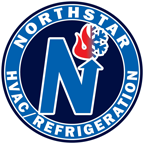Building Decarbonization: The Role of HVAC and Refrigeration
Written by Ed Rice
As industries and governments prioritize climate action, decarbonizing buildings has become a key focus in reducing global greenhouse gas (GHG) emissions. According to the U.S. Department of Energy, buildings account for approximately 40% of total energy use in the United States, with HVAC and refrigeration systems making up a significant portion of that energy demand. Transitioning these systems to greener technologies is essential to achieving carbon neutrality.
In this blog, we’ll explore the role HVAC and refrigeration systems play in building decarbonization, advancements in technology, and actionable steps to make your facility more sustainable.
Why Focus on HVAC and Refrigeration?
HVAC and refrigeration systems are among the largest contributors to energy consumption and GHG emissions in buildings. They rely heavily on electricity, often generated from fossil fuels, and use refrigerants with high Global Warming Potential (GWP). Addressing these factors is critical to reducing energy use and emissions.
Key Impacts:
Energy Consumption: HVAC and refrigeration account for up to 50% of a building's total energy use, depending on the facility type.
Refrigerant Impact: Traditional refrigerants, such as hydrofluorocarbons (HFCs), have high GWPs, significantly contributing to climate change when released into the atmosphere.
The Path to Decarbonization
Electrification of HVAC and Refrigeration Systems
Electrification is at the heart of decarbonization efforts. Transitioning from gas-powered systems to electric heat pumps and other electrified HVAC solutions reduces reliance on fossil fuels. Electric systems paired with renewable energy sources can significantly lower a building’s carbon footprint.
Transition to Low-GWP Refrigerants
Replacing high-GWP refrigerants with alternatives such as CO2 (R744), ammonia (R717), or hydrofluoroolefins (HFOs) is a critical step. These refrigerants have a significantly lower impact on the environment, aligning with global efforts like the Kigali Amendment to phase down HFCs.
Energy Efficiency Upgrades
Investing in high-efficiency HVAC and refrigeration systems can reduce energy consumption by 20-40%. Key upgrades include:
Variable speed drives for motors and compressors.
Advanced heat exchangers.
Smart thermostats and IoT-enabled monitoring.
Heat Recovery and Energy Reuse
Modern systems can capture waste heat from refrigeration and HVAC operations for use in other building systems, such as water heating or space heating, further reducing energy demand.
Smart Building Technology
Integrating advanced controls and automation helps optimize energy usage. Real-time monitoring, predictive maintenance, and demand response strategies ensure systems run efficiently while minimizing energy waste.
Policy and Incentives Supporting Decarbonization
Government policies and incentives are driving the adoption of energy-efficient and low-emission systems. Notable initiatives include:
Inflation Reduction Act (IRA): Offers tax credits and rebates for clean energy upgrades, including HVAC and refrigeration systems.
Mass Save Program: Provides incentives for energy-efficient technologies in Massachusetts, including heat pumps and advanced HVAC solutions.
Building Performance Standards (BPS): Mandate GHG emissions reductions for commercial buildings in cities like Boston, under laws like BERDO 2.0.
How Northstar Refrigeration Can Help
Northstar Refrigeration is committed to supporting your building’s decarbonization journey. Our team specializes in:
Energy Assessments: Identifying inefficiencies and recommending upgrades.
Custom Solutions: Designing and installing systems tailored to your facility’s needs.
Refrigerant Transition Plans: Helping you navigate the shift to low-GWP refrigerants.
Compliance Assistance: Ensuring your systems meet evolving regulations and standards.
The Benefits of Decarbonization
Investing in greener HVAC and refrigeration systems benefits your facility in several ways:
Cost Savings: Lower energy bills and reduced maintenance costs.
Regulatory Compliance: Stay ahead of local and federal mandates.
Environmental Impact: Reduce your building’s carbon footprint and contribute to climate action.
Enhanced Reputation: Position your business as a leader in sustainability.
Final Thoughts
Building decarbonization isn’t just about meeting regulatory requirements—it’s an opportunity to innovate, reduce costs, and make a positive impact on the environment. HVAC and refrigeration systems play a central role in these efforts, and taking proactive steps now can prepare your facility for a greener future.
Ready to decarbonize your building? Contact Northstar Refrigeration at (508) 888-3692 to learn more about our sustainable solutions and how we can help you achieve your energy efficiency and carbon reduction goals.
Edward Rice
Director of Marketing,
Northstar Refrigeration, Inc.
95 Camelot Drive, Unit 1,
Plymouth, MA 02360
erice@northstarhvacr.com www.northstarhvacr.com
p: (508) 888-3692 x115
m: (508) 561-8638



